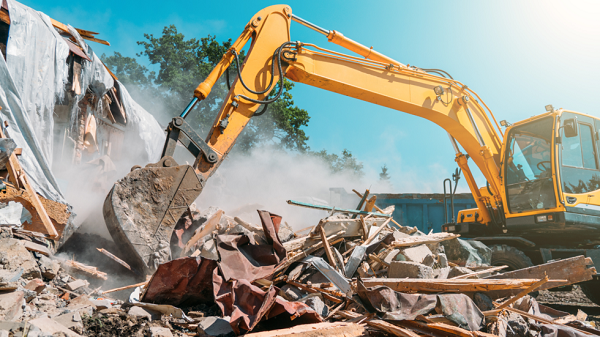Reducing waste on construction sites is more important than ever, as the industry becomes a top contributor to global waste.
According to recent reports, construction and demolition waste accounts for about one-third of all global waste, making sustainability and efficient waste management essential.
Here are seven practical tips to help construction companies reduce waste, save costs, and contribute to a more sustainable future.
1. Implement a Detailed Waste Management Plan
A successful waste reduction strategy starts with a comprehensive waste management plan. This document should outline clear goals and establish procedures for sorting, recycling, and repurposing materials. Key components include:
- Identification of Materials: Classify materials into recyclable, reusable, and non-recyclable categories.
- Designated Disposal and Recycling Areas: Allocate specific on-site spaces for waste sorting to make it easier for workers to dispose of materials correctly.
- Employee Training: Ensure all employees understand waste management procedures and are trained in sustainable practices.
The plan should be revisited and adjusted throughout the project to adapt to any changes in materials or construction methods.
2. Optimize Material Procurement and Use
Careful planning and precise material estimation can prevent over-ordering and material wastage. Here’s how:
- Use Just-In-Time (JIT) Inventory Management: Order materials as needed to avoid surplus, reducing both waste and the cost of storing extra materials.
- Order in Bulk When Possible: Purchasing materials in bulk can reduce the amount of packaging waste generated.
- Accurate Measurements: Use advanced tools and technologies like Building Information Modeling (BIM) to create accurate material estimations, helping minimize cutting errors and leftover scraps.
In addition, explore options to return unused materials to suppliers for a refund or use them on other projects to avoid waste altogether.
3. Maximize Material Recycling and Repurposing
Construction sites generate a variety of materials, many of which can be recycled or repurposed. For example, concrete, wood, and metal often retain value and can be reused. Consider the following strategies:
- On-Site Recycling Stations: Place recycling bins around the site to encourage workers to sort waste materials.
- Collaboration with Recycling Facilities: Partner with nearby recycling facilities that accept construction materials like drywall, metal, and concrete.
- Use of Reclaimed Materials: Incorporate salvaged materials from previous projects when applicable, which can reduce the need for new materials and prevent items from entering the landfill.
By maximizing recycling, construction companies can reduce landfill usage while also reducing material costs for future projects.
4. Embrace Modular and Prefabricated Construction
Modular and prefabricated construction methods allow for the assembly of building components off-site, reducing waste in several ways:
- Precision and Quality Control: Modular components are manufactured with high precision in a controlled environment, leading to fewer errors and less material waste.
- Reduced Scrap: Modular building creates less off-cut material and waste because components are designed to fit perfectly.
- Efficient Material Use: By fabricating building parts in bulk, manufacturers can optimize material use and reduce the waste created by cutting and fitting on-site.
Studies show that prefabrication can reduce on-site waste by up to 90%, making it a powerful option for waste-conscious builders.
5. Encourage Reusable and Sustainable Materials
Many traditional materials, such as concrete and single-use plastics, have non-biodegradable properties that can harm the environment. Switching to sustainable alternatives can minimize waste while promoting eco-friendliness:
- Bamboo, Recycled Steel, and Rammed Earth: These sustainable materials can replace traditional materials and are often biodegradable or recyclable.
- Recycled Plastic: Some construction projects are incorporating recycled plastic products, reducing the need for virgin plastics.
- Durable and Reusable Formwork: Instead of disposable formwork, consider reusable metal or plastic formwork for concrete, reducing waste and saving money on recurring purchases.
Adopting sustainable materials and reusables not only minimizes waste but also supports a project’s sustainability goals and enhances its environmental impact.
6. Practice Effective Waste Sorting
Effective waste sorting ensures that materials end up in the correct recycling or disposal stream, reducing contamination and maximizing recycling potential:
- Color-Coded Bins: Use color-coded bins for different types of waste (e.g., metal, wood, and general waste) to make it easy for workers to dispose of items correctly.
- Clear Signage and Labels: Place clear labels and instructions on all waste bins and collection points, detailing which materials belong in each bin.
- Regular Audits: Conduct regular waste audits to track the types and amounts of waste generated. These audits can provide insights into where waste reduction efforts should be focused.
Sorting waste efficiently is crucial for meeting regulatory standards and ensuring that materials are disposed of sustainably.
7. Educate and Involve the Entire Team
Waste reduction on construction sites requires a collective effort. Educating the entire team—from managers to on-site workers—on waste management practices will encourage everyone to participate actively:
- Workshops and Training: Regularly conduct workshops on waste reduction practices, recycling, and material handling.
- Incentivize Waste Reduction: Offer rewards or incentives for teams that meet waste reduction targets or actively participate in recycling efforts.
- Regular Progress Updates: Keep the team updated on progress made in waste reduction, celebrating achievements and setting new goals to keep morale high.
Engaging workers and making them aware of waste reduction’s impact will enhance commitment to sustainability on-site, leading to long-term behavioral changes.
Final Thoughts
With sustainability becoming increasingly important, implementing these waste reduction tips on construction sites is a proactive way to enhance environmental responsibility and project cost-efficiency.
These strategies not only reduce waste but also promote a culture of sustainability in the construction industry, allowing firms to stay competitive in an eco-conscious world.
By prioritizing waste reduction, construction companies can build with a purpose, minimizing their impact on the environment and laying a solid foundation for a greener future.
Also Read
How to create a sustainable construction Plan: Tips for eco-friendly builds
Tips for improving communication among construction teams

